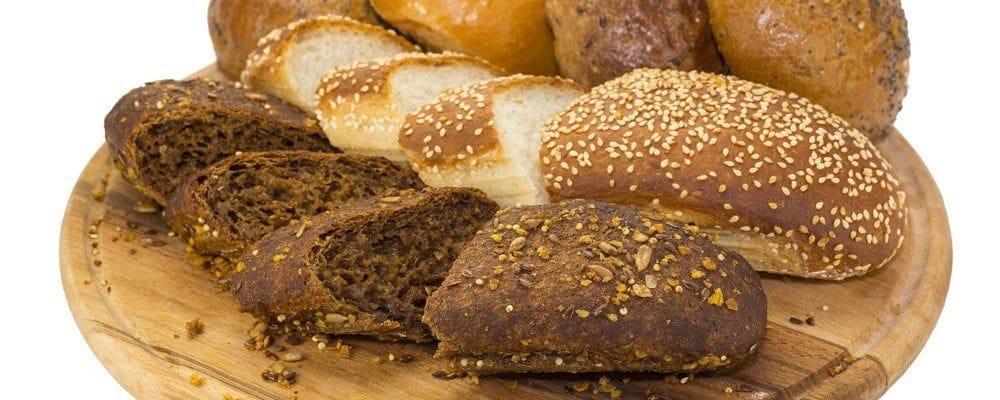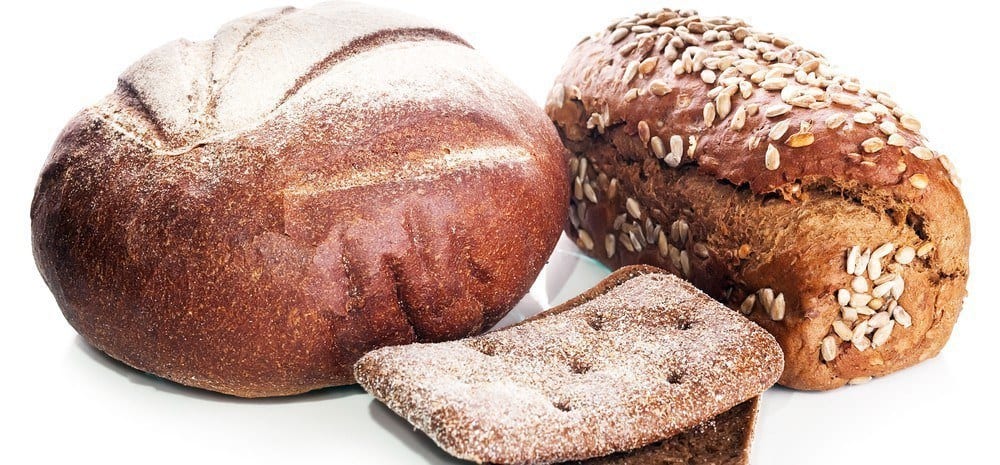
Despite its popularity, a slice of white bread is a particularly unhealthy thing to put into your body. To make it they strip the wheat grain of almost all of its nutrients and fiber, often bleach it with toxic chlorine dioxide, potassium bromate or benzoyl peroxide and then further treat the lifeless refined starch with chemicals such as azocarbonamide, polyoxyethylene monostearate and ammonium chloride.
Now virtually devoid of anything resembling nutrition, the resulting flour is made into a bread that is, in a digestive sense, more similar to table sugar than the whole wheat grain and your body treats it as such.
Whenever you eat large amounts of refined carbohydrates like white bread, high levels of insulin are likely to be produced to deal with it. The hormone insulin shuttles away the rapidly absorbed sugars you’ve just eaten out of your bloodstream, where they present a danger to your body. It then converts them, first into glycogen and then into triglycerides for storage in your body’s fat cells.
While some fats eaten with a big carbohydrate meal may be stored as well, it’s the refined high glycemic foods like white bread that stimulate insulin production the most, leading to the optimal conditions for weight gain.
Sometimes the manufacturers will add back a few synthetically produced vitamins and minerals that your body has problems utilizing. They then claim that the bread is ‘enriched’. An ambitious term some might think after what they’ve done to it.

What’s the Difference Between White Bread vs Brown Bread?
Most white bread made from refined wheat flour gives nothing to your body. In fact, not only is it a premier weight gain food, you’ll actually require more enzymes, vitamins and minerals from the other foods you eat just to deal with digesting it. Given all of this, it would make sense to switch to brown bread or multigrain right? Unfortunately not.
In some extremely lazy manufacturing, but inspired marketing, much of the ‘brown’ bread you’ll find in the supermarket is simply the same white bread with brown coloring, often caramel, added back into it. Hardly the healthier choice it’s made out to be.
Likewise, ‘wholemeal’ bread with a bit of chemically treated wheat germ added back in, or ‘multigrain’, with a sprinkling of softened grains, hardly makes up for what the main ingredient – refined wheat flour – has gone through.
The fact is, the vast majority of breads from the big manufacturers are just slight variations, a little coloring here, a sprinkling of seeds there, of the same extremely unhealthy processed bread. If you’d like to stay healthy and especially if you’re looking to lose weight, they are best ditched from your diet or replaced with some of the healthier alternatives ahead.
What About Whole Wheat Bread?
True whole wheat bread, if you can find it, should be a healthier option. Whole wheat bread is made with the wheat germ and the bran included and is hopefully not as heavily processed or full of chemical additives as most commercial loaves. It’s higher fiber content helps to slow down its digestion and therefore its effect on your blood sugar and levels of fat storing insulin shouldn’t be as pronounced.
Even given all of that though, it’s debatable whether even whole wheat bread is a truly healthy option. The problem is wheat itself. Perhaps with the exception of corn, no grain has been as hybridized and tampered with over the last 50 years. The levels of gluten in particular, an allergenic protein that more and more people seem to have problems dealing with, have risen dramatically due to selective breeding programs.
Hybridization has also employed some highly questionable techniques to change traditional wheat into what it is today. These include exposing wheat seeds to gamma irradiation and toxic sodium azide to induce mutations. The goal has never been to make a healthier food and some research suggests compounds like gliadin in wheat have been deliberately changed to help stimulate appetite.

3 Healthier Replacements
The page on Why Bread Makes You Fat goes into detail about all the reasons why it’s best to avoid grain foods for a while if you’d like to be a bit slimmer. If you’re happy with your weight and would still like to have bread occasionally here are 3 relatively healthy replacements.
1. Rye Bread
While it’s a little harder to find on supermarket shelves dominated by processed wheat versions, rye bread is usually much less refined and the healthier choice. It is much higher in fiber than even whole wheat bread and tends to fill you up and satisfy your hunger more than most appetite stimulating bakery goods.
Rye bread is also considered a much better choice for both lowering your risk of developing diabetes and for those who are already living with the disease. This is due to the gentler effect it has on blood sugar and its good levels of minerals like magnesium.
Traditional rye bread like this has a rich, nutty flavor, can help you lose weight and will keep your energy levels much more stable than high glycemic white bread. If you think you really can’t give up bread, even for a short period, then try replacing it with a real bread like traditional rye.
2. Spelt Bread
The spelt grain is a distant cousin of wheat with a nutty flavor and a better range of nutrients. Because spelt hasn’t been subjected to the same kind of hybridization as wheat, it is rarely reported to cause allergies and intolerances, even for those people who are very sensitive to regular bread.
Like rye, spelt bread is usually higher in fiber than regular wheat bread and has a good range of minerals like manganese, phosphorus, magnesium and copper and natural vitamins like niacin, thiamine and folate.
Bread made from spelt is likely to be the most similar to wheat bread for people looking to make a healthier change without going too far from the texture and taste they’re used to. Spelt sourdough is a particularly tasty option you can sometimes find at specialty bakeries or health stores and freeze for a regular supply.
3. Wheat-Free Breads
Many wheat free breads are a blend of grains like spelt and rye mixed with other healthier grains such as barley, oats, millet and even pseudo-grains like amaranth and quinoa. It’s worth checking that they are whole grain breads and low on additives with chemical names, but generally these type of breads provide a much healthier option that will fill you up, be less likely to lead to weight gain, have much more nutritional value and promote better overall health and energy.

Eating Less Bread
Most of the mass-produced bread we eat is much less healthy than many people realize. Nutritionally empty, it promotes blood sugar rises, hunger and body fat storage and is playing a significant part in the obesity epidemic gripping western societies.
Unfortunately it’s not really about white bread vs brown bread. Ultimately wheat itself is likely to be the problem for many people when it comes to constant hunger, dramatic energy fluctuations and difficulty losing weight.
Whole grain, wheat-free breads like traditional rye and spelt bread are a much healthier option. They’re a little more and they are harder to find, but they’re definitely worth it if you value your health. Look around for one you like and when you find it get a couple of loaves and keep them in the freezer.
Remember though, even healthy breads like this are highly concentrated foods and are best eaten earlier in the day rather than in the evening and more as an occasional treat than a dietary staple. Many people notice a significant difference when they reduce grain based foods, particularly around their waistline and in their daily energy levels.
Great article as usual, though I was fairly horrified to hear that brown bread is often just white bread with colouring! And here I was thinking I was being good all these years, they really have pulled the wool over our eyes (and I don’t know about anyone else, but I’m pissed about it).
In terms of alternatives I’ve always been partial to pita bread. Rye’s a bit heavy for my tastes, though I quite like spelt so I’ll have to keep an eye out for it the next time I’m at the bakery.
Thanks for your comments Kelly. I think a lot of people would be surprised to find that brown bread is often fairly similar nutritionally to white bread. If the ingredient list contains caramel or ‘natural coloring’ that’s usually a good indication that there’s not much difference.
Pita is potentially a little lighter on the chemicals that make white bread spongy but the real key is avoiding wheat and finding breads made out of other less tampered with grains.
Bigger health food stores and online specialty sites are a good option for spelt, rye and other healthier breads.
Thanks for this wonderful article. it reinforces my choice to not get white bread. How’s this for my bread label ingredients? Whole sprouted grains of red wheat berries, quinoa, oat grouts, rye berries,barley, amaranth, and millet, water wheat flour, 100 percent domestic honey, vital wheat gluten, oat fiber, yeast salt molasses. Per slice 60 c. 11 carb. 2 fiber 1 sugar. 3 protein This and other varieties. ( I will have to check out the rye). Are made locally at the Angelic Bakehouse in Waukesha, WI. I buy several and double bag and freeze
Hi Teresa and thanks for your comments.
This is definitely a much healthier bread than anything you’re likely to find in a supermarket.
I’d still maintain that grain foods are better in smaller amounts than most people eat and even avoided for a while for anyone wanting to lose weight. But as far as breads go this sounds like a good choice.
Best Regards,
Jim
Hi.. l used to work with a dermatologist & nutritionist Dr Azimuth said that Baker’s yeast in most bread is a good immune booster for our skin & health but, whole meal & whole grains are much better than the white ones. l’m sorry abt the colored brown bread in yr country, but in Malaysia, any brown bread is a true whole meal except a few cheap ones. Anyway, thanks for the info 🙂
Hi Intan and thanks for your comments.
Baker’s yeast does have some nutritional properties but you’d be better off using it as a supplement than relying on supermarket bread for it. I don’t know a great deal about bread production in Malaysia but the manipulation of the wheat crop is worldwide. It might also be worth looking up some of the additives you find on the ingredients list of your bread and seeing if you’re happy eating those daily.
A generally health person can probably handle a bit in moderation but there’s a good case to be made for most bread being less than healthy.
Thanks for giving dis information, I am dietician but i don’t know that brown bread is similar to white bread nutritionally and it is only colored white bread , so next time i will be very careful when i buy brown bread…
THE ALMIGHTY LOAF IS BETTER THAN ALLLLL
Thanks for the article Jim! 🙂 I knew white bread was unhealthy and this backed me up in more detail so I now know more. Thank You.
ppoooommaann wwwwwwwwwwooooooooooooooooooooooooooooooooooooooooooo
Stupid article based on pseudoscience and bullshit.
this is nonsense,it does not make any difference to the quality of your life,only a matter of preference.